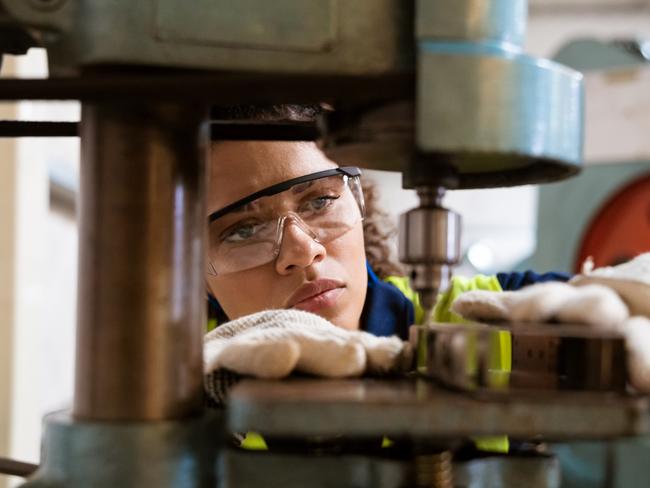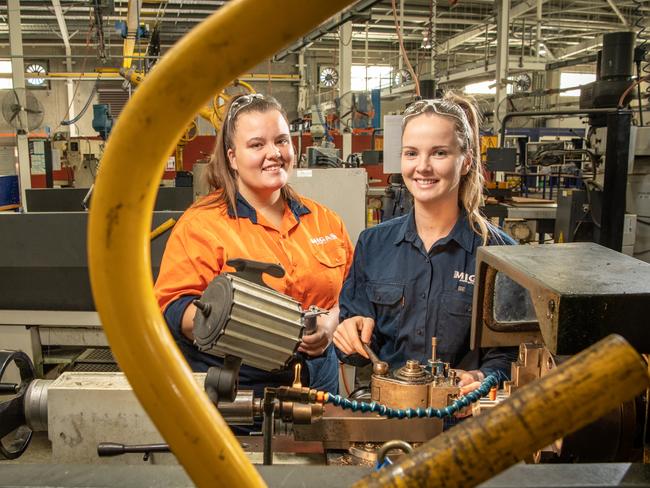National Skills Week: How to get an apprenticeship
It’s National Skills Week, making it the ideal time for anyone considering an apprenticeship or traineeship to put their plan into action.

Careers
Don't miss out on the headlines from Careers. Followed categories will be added to My News.
Apprenticeships are the starting point for more than 500 different jobs, and allow workers to earn while they learn.
They can be done full time or part time, and anyone of working age is eligible to apply.
So how do you get one? There are a few options.
CONTACT EMPLOYERS DIRECTLY
Jobseekers interested in learning a trade can go straight to an employer by responding to a job ad, such as those listed in the Careers section, or by introducing themselves and asking if there are any roles available.
They may also be able to find a position through their network if they have a family member or friend who owns a trade business and is looking to hire.
REACH OUT TO A GTO
A Group Training Organisation, or GTO, employs apprentices and trainees then finds a suitable host for them to work with day to day.
Businesses that may not be able to employ an apprentice or trainee for the full length of their training can host them for a nominated period then they can be placed with another employer.

MIGAS Apprentices and Trainees chief executive David Hoey says aspiring apprentices can think of GTOs as their support partner while completing their apprenticeship.
“MIGAS is there from commencement to completion with a dedicated team member connecting with the apprentice regularly by phone and at work,” he says.
“Our reason for being is to support the apprentice through the wins and challenges that come along with learning a new trade, studying and, in many cases, taking on their first job.”
DO A SCHOOL-BASED APPRENTICESHIP
These allow year 10, 11 and 12 students to undertake a vocational qualification as a trainee or apprentice while still finishing their high school education.
They typically work one or two days a week, putting them half a year ahead in their training compared to if they had started their apprenticeship after graduating high school.
Students can talk to their school about setting this up.
DO A PRE-APPRENTICESHIP
This is an entry-level course – such as a certificate II – comprising classroom learning and hands-on work experience.
Hoey says pre-apprenticeships can help to improve literacy and numeracy skills as well as develop essential work-related skills.
“These skills can help you be better prepared for work and be a standout job candidate,” he says.

CONSIDER VOLUNTEERING
Aspiring apprentices can also get a taste of a trade by doing work experience or volunteering with an employer for a short period of time.
Hoey says this is useful as an apprenticeship can be a three to five-year commitment.
“If you’re interested in a particular trade area, volunteer and offer your time for work experience to help you decide whether it’s the right career for you,” he says.
HAVE THE RIGHT SKILLS AND ATTITUDE
Hoey says securing an apprenticeship is just like applying for a job.
“It’s a competitive process and all about demonstrating a genuine commitment to both working and learning,” he says.
“Attitude, motivation and keenness are fantastic attributes that we look for when meeting apprentice candidates, especially for school leavers who may not yet have the relevant work experience under their belts.”
He recommends spending the time to put together a professional cover letter and resume.
“If you’re lacking work experience, then demonstrate you’ve researched the trade area
by reading up about the qualification and what type of work it involves,” he says.
Hoey says having a driver’s licence and good high school grades in maths can also help in many trades.
MEET EMMA SCOTT AND TEAH OLSEN
The apprentice fitter and turners are employed by MIGAS, and hosted by The Queensland Brain Institute and Arnott’s, respectively.
They will represent Queensland in their trade at the WorldSkills Australia National Championships, which begin August 26.
More than 500 competitors will showcase talents across 50-plus skills and trades, competing for a chance to represent Australia at the International Competition in Shanghai next year.

What’s your trade in a nutshell?
Scott: (Fitters and turners) design and fabricate components from metal as well as repair and maintain equipment. (We use) machinery such as manual or CNC milling machines and lathes and also have the ability to produce high quality welds, use CAD software and use problem solving skills.
How did you get your apprenticeship?
Scott: I spoke to MIGAS (which) put me into an apprenticeship for cabinet making but I decided to change to fitting and turning (as) I had a desire to challenge myself and be more creative with my design skills.
Olsen: I started looking for apprenticeships before I graduated school. I spent months searching online and through other apprenticeship groups. Fortunately, I had kept in contact with the careers teachers from school who then connected me with MIGAS and I kept going from there.
Advice for aspiring apprentices?
Olsen: Reach out to people who can help you and get your name in the game. Put your best foot forward and show interest in the trade when applying and attending interviews. Don’t be afraid to ask questions, it will give a good first impression if you are engaged.
Tell us about representing QLD at WorldSkills?
Scott: I have been training once a week for three months to prepare myself for the complex turning that will be required. This includes offset turning, mating tapers, 2 start left-hand threads, etc. Most dimensions must be within 0.01mm tolerance.
Olsen: Over the past months, I have spent every Friday at TAFE training, focusing on my skills that I don’t use everyday to make sure I’m confident going into the competition.
If you would like to learn more about apprenticeships, traineeships and industry trends for the next five to 15 years, view The Skills and Thrills Digital Student Showcase, a free half-hour video resource for high school students and parents. It is available until September 17.
Originally published as National Skills Week: How to get an apprenticeship




